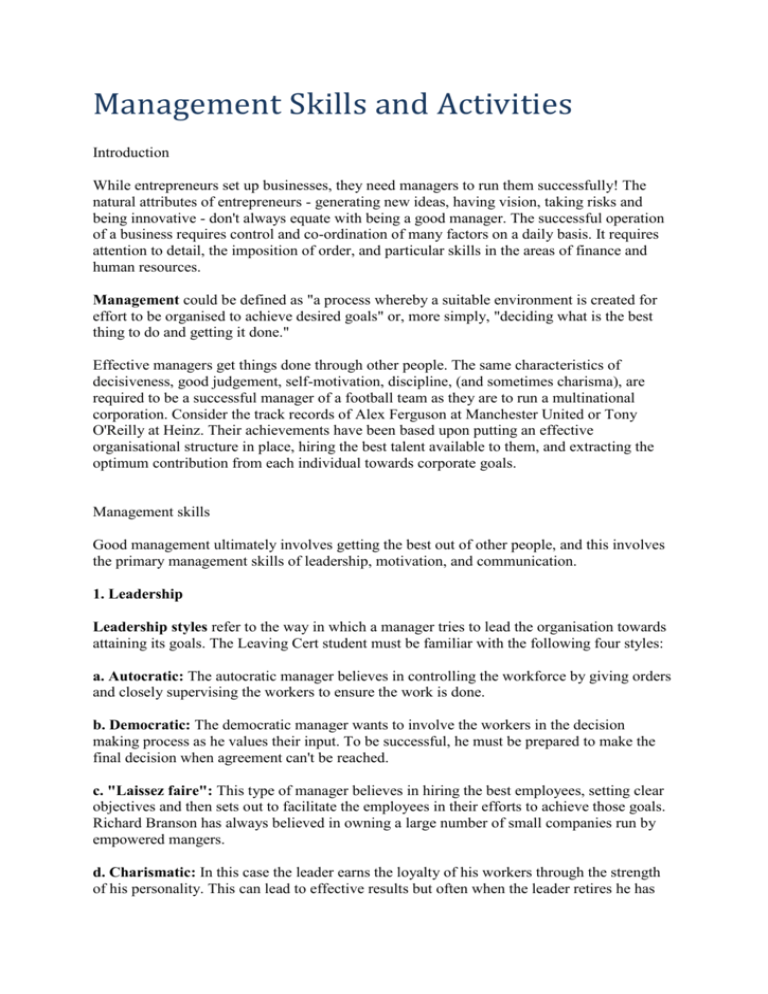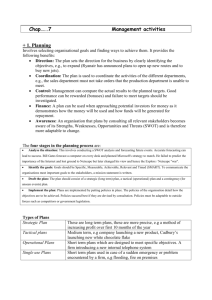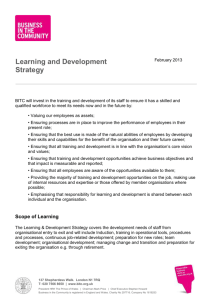Management Skills & Activities: Leadership, Motivation, Planning
advertisement

Management Skills and Activities Introduction While entrepreneurs set up businesses, they need managers to run them successfully! The natural attributes of entrepreneurs - generating new ideas, having vision, taking risks and being innovative - don't always equate with being a good manager. The successful operation of a business requires control and co-ordination of many factors on a daily basis. It requires attention to detail, the imposition of order, and particular skills in the areas of finance and human resources. Management could be defined as "a process whereby a suitable environment is created for effort to be organised to achieve desired goals" or, more simply, "deciding what is the best thing to do and getting it done." Effective managers get things done through other people. The same characteristics of decisiveness, good judgement, self-motivation, discipline, (and sometimes charisma), are required to be a successful manager of a football team as they are to run a multinational corporation. Consider the track records of Alex Ferguson at Manchester United or Tony O'Reilly at Heinz. Their achievements have been based upon putting an effective organisational structure in place, hiring the best talent available to them, and extracting the optimum contribution from each individual towards corporate goals. Management skills Good management ultimately involves getting the best out of other people, and this involves the primary management skills of leadership, motivation, and communication. 1. Leadership Leadership styles refer to the way in which a manager tries to lead the organisation towards attaining its goals. The Leaving Cert student must be familiar with the following four styles: a. Autocratic: The autocratic manager believes in controlling the workforce by giving orders and closely supervising the workers to ensure the work is done. b. Democratic: The democratic manager wants to involve the workers in the decision making process as he values their input. To be successful, he must be prepared to make the final decision when agreement can't be reached. c. "Laissez faire": This type of manager believes in hiring the best employees, setting clear objectives and then sets out to facilitate the employees in their efforts to achieve those goals. Richard Branson has always believed in owning a large number of small companies run by empowered mangers. d. Charismatic: In this case the leader earns the loyalty of his workers through the strength of his personality. This can lead to effective results but often when the leader retires he has neglected to put a system in place. Kevin Keegan has been noted for his charismatic style of leadership. Two key areas of leadership are direction and delegation. These involve practical applications of leadership in the workplace: a. Direction: It is essential that management sets the targets for the firm and that these are communicated clearly to all the stakeholders. In order to achieve this aim most modern firms adopt a mission statement. For example the ESB states, "ESB will be a world class company focusing primarily on the energy market, delivering quality products and services to our customers." In addition the managers must establish a corporate culture which encourages the employees to believe in the mission. In a Sunday Times survey, a company called Capital One wasjudged to be the third best company to work for in the UK. Its policies included "share options for everyone, casual dress everyday, above average pay, fitness centres, fiveweek holidays and community involvement." b. Delegation: This is the ability of managers to pass responsibility and authority to subordinates to achieve clearly communicated goals. The subordinates must be given time and space to work but they will also be held accountable to the manager for the successful completion of the tasks. Without delegation, an organisation will find growth difficult to achieve. 2. Motivation Motivation is the ingredient which drives people to achieve certain goals, and it comes from within the person. Theories abound as to how to activate this process - Maslow's "hierarchy of needs" and McGregor's "Theory X and theory Y" are the most commonly applied - but usually motivational requirements are best addressed with reference to the 'three Rs' of Respect, Recognition, and Reward. To find out more about Maslow and McGregor, click here. 3. Communication Managers must have good communication skills - the ability to listen, to articulate ideas, to convey corporate plans clearly to their team in the most appropriate manner, using the most effective language. Effective communication by a manager must include the following: Be clear about the message he/she intends to communicate. This means the manager should plan all formal communications and take great care when communicating informally. When the chief executive of Ratners stated during a televised interview that all the jewellery sold in their shops was junk he was guilty of a communication error, which ultimately led to the failure of his company. Select the correct medium so that the message reaches the target audience. Ensure the message is sent in a timely fashion. Make sure the message is accurate and easy to decode by the receiver. Finally the sender must include a feedback system to check the message has been received and understood. Common barriers to effective communication are: Lack of trust: A message will not be believed if the receiver does not trust the source. Listening: If the receiver is not listening or concentrating the message will be lost. Language used: If the message contains technical jargon or "buzzwords" a wide audience will not understand it. Incorrect medium: Management should choose a medium appropriate to the message. The results of individual performance appraisal should not be posted on the staff notice board. Lack of feedback: If the receiver fails to respond or if there are no procedures allowing for response then the sender will never know if the message got through. Length of communication lines: If the message has to pass through too many channels it may be distorted. Types of communication To discover more about the three main types of communication (oral, written and visual) Communication and information technology Information technology has become vital to the success of business as: It increases the speed and quantity of information that can be transmitted. It can integrate information from all parts of the organisation, thus allowing for informed decisions. It can lead to a reduction in the levels of management hierarchy (a process known as "de-layering"). It allows business to become global. The Leaving Cert student should be able to discuss the impact of Electronic Data Interchange (EDI), ISDN lines, video conferencing, the Internet, e-mail and e-commerce. Management activities When asked to discuss management activities the Leaving Cert student should confine discussion to the areas of planning, organising and controlling. 1. Planning involves selecting organisational goals and finding ways to achieve them. It provides the following benefits: Direction: The plan sets the direction for the business by clearly identifying the objectives, e.g., to expand (Ryanair has announced plans to open up new routes and to buy new jets). Coordination: The plan is used to coordinate the activities of the different departments, e.g., the sales department must not take orders that the production department is unable to meet. Control: Management can compare the actual results to the planned targets. Good performance can be rewarded (bonuses) and failure to meet targets should be investigated. Finance: A plan can be used when approaching potential investors for money as it demonstrates how the money will be used and how funds will be generated for repayment. Awareness: An organisation that plans by consulting all relevant stakeholders becomes aware of its Strengths, Weaknesses, Opportunities and Threats (SWOT) and is therefore more adaptable to change. The four stages in the planning process are: Analyse the situation: This involves conducting a SWOT analysis and forecasting future events. Accurate forecasting can lead to success. Bill Gates forecast a computer on every desk and planned Microsoft's strategy to match. He failed to predict the importance of the Internet and lost ground to Netscape but later changed his view and hence the Explore / Netscape "war". Identify the goals: Goals should be Specific, Measurable, Achievable, Relevant and Timed (SMART). To communicate the organisations most important goals to the stakeholders, a mission statement is written. Draft the plan: The plan should consist of a strategic (long term) plan, a tactical (operational) plan and a contingency (for unseen events) plan. Implement the plan: Plans are implemented by putting policies in place. The policies of the organisation detail how the objectives are to be achieved. Policies succeed best if they are devised by consultation. Policies must be adaptable to outside forces such as competitors or government legislation. 2. Organising means bringing people and resources together to achieve a common objective. An organisational structure identifies the different functions in an organisation and sets out the power structure. This can be represented in an organisational chart. The simplest organisational chart is the functional structure, which divides a business according to management functions at senior, middle management and junior levels. There are three layers of management in this chart: top, middle, and junior management. It indicates where authority and responsibility have been delegated. It illustrates the chain of command, i.e., who is answerable to who. It shows the managing director's span of control (the number of people reporting directly to a manager). Leaving Cert students should know how to describe several types of organisational structures such as matrix, geographical team, and Handy's shamrock structure. De-layering the organisation refers to the reduction in the number of layers in the management structure of the organisation. This process has the following advantages: It simplifies the structure. It increases the speed and accuracy of internal communication, which means the organisation can respond more rapidly to change. De-layering gives more power to subordinates. This increase in responsibility can release creativity and initiative. It reduces the total wage bill paid to managers. The disadvantages of de-layering are: Senior managers have to deal with a wider span of control and an increased workload. This may cause stress. Managers' jobs may be lost through redundancies and this may lead to industrial relations problems. Control becomes more difficult as the span of control increase. 3. Controlling Management control refers to the monitoring and checking of results to see that they agree with the targets set out in the plan. Control is important to managers because: Correction: A good control system allows management detect and correct problems before they get out of control. If Barings Bank had better control systems, Nick Leeson would not have been able to bankrupt the company. Quality: The control system will ensure service to the customers remains at the highest level. This may be achieved by creating a total quality management system in the organisation and by the introduction of quality awards.. Efficiency: Waste is reduced in all areas of the organisation when corrective action is prompt. Profits: Profits should increase due to a reduction in costs associated with waste and defective products. Sales revenue may increase due to the ability to charge a premium price for a high quality product. The control process involves: Setting targets Measuring performance against the targets Investigating any variance Correcting problems Preventing deviations by anticipating problems The Leaving Cert student should be familiar with the following types of management control: stock control, credit control, environmental audit, break-even analysis, quality control and financial control.






